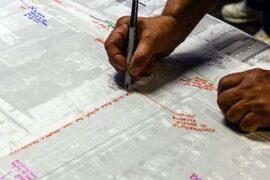Gabriel Ehrlich and Michael McWilliams from the Research Seminar in Quantitative Economics (RSQE) at the University of Michigan presented the economic outlook for Washtenaw County during a luncheon organized by the Washtenaw Economic Club — an event that Ann Arbor SPARK is proud to sponsor. The event took place at The Kensington Hotel in Ann Arbor on March 24, 2022, and marked the return to in-person Washtenaw Economic Club events. Ann Arbor SPARK’s Director of Research Melissa Sheldon, who moderated the event, provided this high-level summary of the Washtenaw County Forecast.
Washtenaw County’s economy continued to recover from the losses it suffered at the beginning of the COVID-19 pandemic and recession throughout 2021 and, according to RSQE, improvement is expected to continue through 2024. Washtenaw County’s overall payroll employment level is expected to surpass the pre-pandemic level by mid-2023 and the unemployment rate is expected to decline to 2.7 percent. This is great news for our region and for blue-collar jobs for which recovery has been strong. However, recovery for the lower-education services sector has been slow and employment levels are expected to remain slightly lower (3 percent) than the pre-pandemic levels by the end of 2024.

RSQE identified a prominent pattern in this year’s forecast in that industries with higher average wages are more likely to make a full employment recovery by 2024 than industries with lower average wages. Industries not expected to make a full recovery by the end of 2024 include accommodation and food services; arts, entertainment, and recreation; retail trade; natural resources and mining; and other services.
Inflation continues to be a risk for the local and national economy and is currently running at its fastest pace in 40 years. Inflation is expected to remain high in the near term, but there is hope that the Federal Reserve can engineer a “soft landing,” in which it brings down inflation without undermining the recovery in the labor market. Despite these inflation trends, average real wages in both the state and county have increased substantially over the past 3 years.
New for the 2022 outlook is RSQE’s analysis of employment and wages in computer and math occupations and how Washtenaw County stacks up against peer communities. The county has a higher share of computer and math jobs than the nation overall, but local wages in these occupations are lower than the national average after adjusting for the cost of living. To remain a technology-driven community, Washtenaw will need to find ways to pay more competitively in these occupations — especially now that the potential exists for more than 20 percent of all work hours nationally to be performed remotely through 2024 and beyond.










